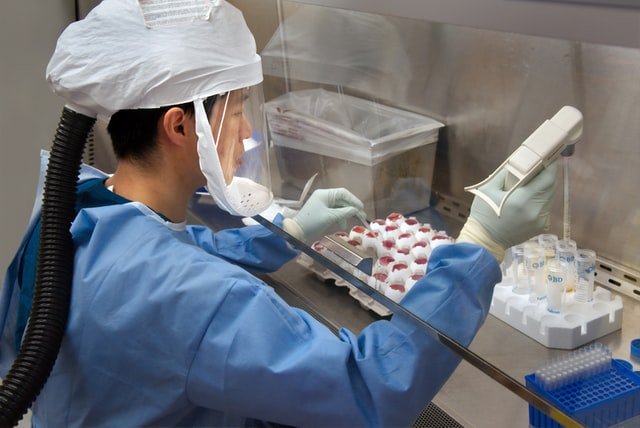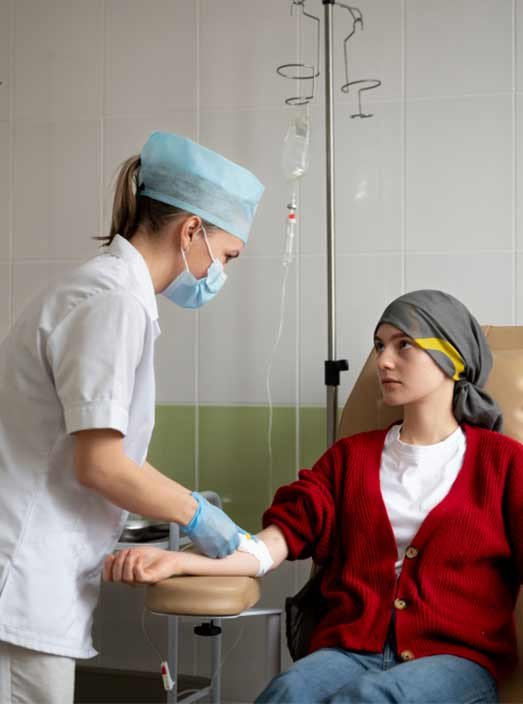Breast Cancer
- devbio
- June 26, 2023
About the breast
The breast is made up of many tissues that range from highly fatty to very dense. A network of lobes exists inside this tissue. Each lobe is made up of lobules, which are little tube-like structures that contain milk glands. The glands, lobules, and lobes are linked by small ducts that transport milk from the lobes to the nipple. The nipple is at the center of the areola, which is the darker region surrounding the nipple.
About breast cancer
When healthy cells in the breast alter and expand out of control, they create a tumor, which is a mass or sheet of cells. Tumors can be malignant or noncancerous. A malignant tumor is one that has the potential to develop and spread to other regions of the body. The term “benign tumor” refers to a tumor that can develop but hasn’t spread.
This guide covers non-invasive (stage 0) as well as early-stage and locally progressed invasive breast cancer (stages I, II, and III), as well as non-invasive (stage 0). The stage of breast cancer refers to how far the disease has progressed as well as whether or not it has spread.
Although breast cancer most usually spreads to surrounding lymph nodes, in which case it is still termed a local or regional illness, it can also spread to places such as the bones, lungs, liver, and brain through the blood arteries and/or lymph nodes. Metastatic breast cancer, often known as stage IV breast cancer, is the most advanced stage of the illness. However, the presence of neighboring lymph nodes does not always indicate stage IV breast cancer.
Types of breast cancer :
Breast cancer can be invasive or non-invasive. Invasive breast cancer is cancer that has spread to surrounding tissues or distant organs. Non-invasive breast cancer does not spread beyond the ducts or lobules of the breast. There are several types of breast cancer, which are classified according to what they look like under a microscope.
Ductal carcinoma: This is the most common type of breast cancer.
Ductal carcinoma in situ (DCIS): This is a non-invasive cancer (stage 0) that is located only in the duct and has not spread outside the duct.
Invasive or infiltrating ductal carcinoma: This is cancer that has spread outside of the ducts or lobules.
Invasive lobular carcinoma: This is a less commonly occurring type of breast cancer that has spread outside of the ducts or lobules.
Less common types of breast cancer include:
- Medullary
- Mucinous
- Tubular
- Metaplastic
- Papillary
- Micropapillary
- Apocrine
Inflammatory breast cancer:
- Which is an aggressive type of cancer that accounts for about 1% to 5% of all breast cancers.
- Paget’s disease, which is a rare type of cancer in the skin of the nipple or in the skin closely surrounding the nipple. It begins in the ducts of the nipple, then spreads to the nipple surface and the areola (dark circle of skin around the nipple). The nipple and areola often become scaly, red, itchy, and irritated. Although it is usually non-invasive, it can also be an invasive cancer. It is usually found with an underlying breast cancer.
Symptoms & Signs:
When a person is initially diagnosed with breast cancer, they may not notice any physical changes (signs) or symptoms. Symptoms are physical changes that you can notice. Changes in anything measured, such as your blood pressure or a lab result, are signs. Symptoms and indicators, when combined, can assist explain a medical condition.
However, some people have symptoms and signs when they are first diagnosed with breast cancer. Talk to your doctor if you experience any of the following symptoms or signs. In many cases, the cause of symptoms and signs may be a non-cancerous condition.
- A lump that feels like a hard knot or a thickening in the breast or under the arm. It is important to feel the same area in the other breast to make sure the change is not a part of healthy breast tissue in that area.
- Change in the size or shape of the breast
- Nipple discharge that occurs suddenly, is bloody, or occurs in only 1 breast
- Physical changes, such as a nipple turned inward or a sore located in the nipple area
- Skin irritation or changes, such as puckering, dimpling, scaliness, or new creases
- A warm, red, swollen breast with or without a rash with dimpling resembling the skin of an orange, called “peau d’orange”
- Pain in the breast, particularly breast pain that does not go away. Pain is not usually a symptom of breast cancer, but it should be reported to a doctor.
Risk Factors :
When considering your breast cancer risk, keep in mind that the vast majority of women who have breast cancer have no obvious risk factors or a significant family history of the disease. Breast cancer is influenced by a number of risk factors. As a result, everyone should be aware of changes in their breasts. They should also discuss with their doctor whether they should get frequent doctor-assisted breast examinations and mammograms. A mammogram is a breast x-ray that can detect tumors that are too tiny to be felt.
The following factors may raise a person’s risk of developing breast cancer:
Age : The risk of developing breast cancer increases with age, with most cancers developing after age 50. The median age for developing breast cancer is 63.
Personal history of breast cancer: A woman who has had breast cancer in 1 breast has a higher risk of developing a new cancer in the other breast.
Family history of breast cancer: Breast cancer may run in the family in any of these situations:
- 1 or more women are diagnosed with breast cancer at age 45 or younger
- 1 or more women are diagnosed with breast cancer before age 50 with an additional family history of cancer, such as ovarian cancer, metastatic prostate cancer, and pancreatic cancer
- There are breast and/or ovarian cancers in multiple generations on 1 side of the family, such as having both a grandmother and an aunt on the father’s side of the family who were both diagnosed with 1 of these cancers
- A woman in the family is diagnosed with a second breast cancer in the same or the other breast or has both breast and ovarian cancer
- A male relativeis diagnosed with breast cancer
Personal experience with ovarian cancer : BRCA1 and BRCA2 gene abnormalities significantly raise the risk of ovarian and breast cancer. As a result, a person who has hereditary ovarian cancer caused by a BRCA gene mutation is more likely to get breast cancer.
Early menstruation and late menopause : If menstruation began before the ages of 11 or 12, or menopause occurred beyond the age of 55, there is a slightly increased chance of breast cancer. This is due to the fact that the breast cells have been exposed to estrogen and progesterone for a longer period of time.
Timing of pregnancy : A first pregnancy beyond the age of 35, or if you’ve never had a full-term pregnancy, increases your chance of breast cancer.
Hormone replacement therapy after menopause : Using estrogen and progestin-containing hormone therapy after menopause, also known as postmenopausal hormone therapy or hormone replacement therapy, within the last 5 years or for several years increases the risk of breast cancer.
Oral contraceptives or birth control pills : Some studies suggest that using oral contraceptives to prevent conception increases the chance of developing breast cancer marginally, while others find no relation between the use of oral contraceptives and the development of breast cancer.
Race and ethnicity : Other than skin cancer, breast cancer is the most prevalent cancer diagnosis among women, regardless of race. White women are more likely than Black women to have breast cancer, however among women under the age of 45, Black women outnumber White women.
Treatment
Surgery : During an operation, the tumor and some surrounding healthy tissue are removed. Surgery is frequently performed to evaluate the axillary lymph nodes, which are located beneath the arm. The types of surgery for breast cancer include the following:
Lumpectomy : The tumor and a narrow, cancer-free margin of healthy tissue surrounding the tumor are removed. The majority of the breast is still present. Radiation therapy to the residual breast tissue is frequently indicated following surgery for invasive cancer, particularly for younger patients, patients with hormone receptor-negative tumors, and patients with bigger tumors.
Mastectomy : This procedure involves the surgical removal of the whole breast. Mastectomies are classified into numerous categories. Discuss with your doctor if the skin, known as a skin-sparing mastectomy, or the nipple, known as a nipple-sparing mastectomy or total skin-sparing mastectomy, may be retained.
Lymph node removal, analysis, and treatment
Sentinel lymph node biopsy : The surgeon detects and removes 1 to 3 or more lymph nodes from beneath the arm that receive lymph drainage from the breast during a sentinel lymph node biopsy (also known as a sentinel node biopsy or SNB).
Axillary lymph node dissection : The surgeon removes several lymph nodes from beneath the arm during an axillary lymph node dissection. A pathologist then examines these for cancer cells.
Radiation therapy : The use of high-energy x-rays or other particles to eliminate cancer cells is known as radiation therapy. A radiation oncologist is a doctor who specializes in the use of radiation therapy to treat cancer. Radiation treatment is classified into numerous types:
- Radiation treatment during surgery: This is when radiation therapy is administered in the operating room using a probe.
- Brachytherapy: Radiation therapy of this sort is administered by inserting radioactive sources into the tumour.
- Partial breast irradiation: Partial breast irradiation (PBI) is radiation therapy that targets only the tumor location rather than the entire breast. It is more prevalent following a lumpectomy. Directly targeting radiation to the tumor region generally reduces the amount of time patients need to undergo radiation therapy.
- Intensity-modulated radiation therapy : Intensity-modulated radiation treatment (IMRT) is a more sophisticated method of treating the breast using external-beam radiation therapy: The radiation energy focused at the breast is changed to better target the tumor and disseminate the radiation more uniformly across the breast.
Adjuvant radiation therapy is given after surgery. The majority of individuals who get a lumpectomy also receive radiation treatment. Depending on the characteristics of the tumor, patients who have had a mastectomy may or may not require radiation therapy.
- Chemotherapy :
- Hormonal therapy :
Hormonal therapy, also known as endocrine therapy, is a successful treatment for most cancers that test positive for either oestrogen or progesterone receptors. This form of tumour uses hormones to drive its development. When hormonal treatment is administered alone or in conjunction with chemotherapy, blocking the hormones can help reduce cancer recurrence and mortality from breast cancer.
- Targeted therapy :
- Immunotherapy :
Prevention
For those at higher risk, the following options may help reduce your risk of breast cancer.
Lifestyle choices : Regular physical activity is one strategy to reduce your risk of breast cancer. According to research, 30 to 60 minutes of moderate- to high-intensity physical activity each day is connected with a decreased risk of breast cancer. Other measures to reduce your risk include maintaining a healthy weight and refraining from using oral contraceptives or hormone replacement treatment after menopause. Breastfeeding may also lessen the chance of developing breast cancer.
Surgery to lower cancer risk : When a BRCA1 or BRCA2 genetic mutation is present, which significantly increases the risk of breast cancer, preventative breast removal may be considered. This is known as a preventive mastectomy. It appears to lower the chance of developing breast cancer by at least 90% to 95%.
Drugs to lower cancer risk : Tamoxifen (available as a generic drug). Tamoxifen is classified as a selective estrogen receptor modulator (SERM). It is frequently used as a treatment for people who already have breast cancer.
Raloxifene (available as a generic drug). Raloxifene is a SERM as well. It is frequently used to prevent osteoporosis (bone thinning) after menopause.
Aromatase inhibitors (AIs). AIs lower estrogen levels in the body by inhibiting estrogen production. When there is a greater chance of developing breast cancer after menopause, three AIs may be considered: exemestane (Aromasin), anastrozole (Arimidex), and letrozole (Femara).
















